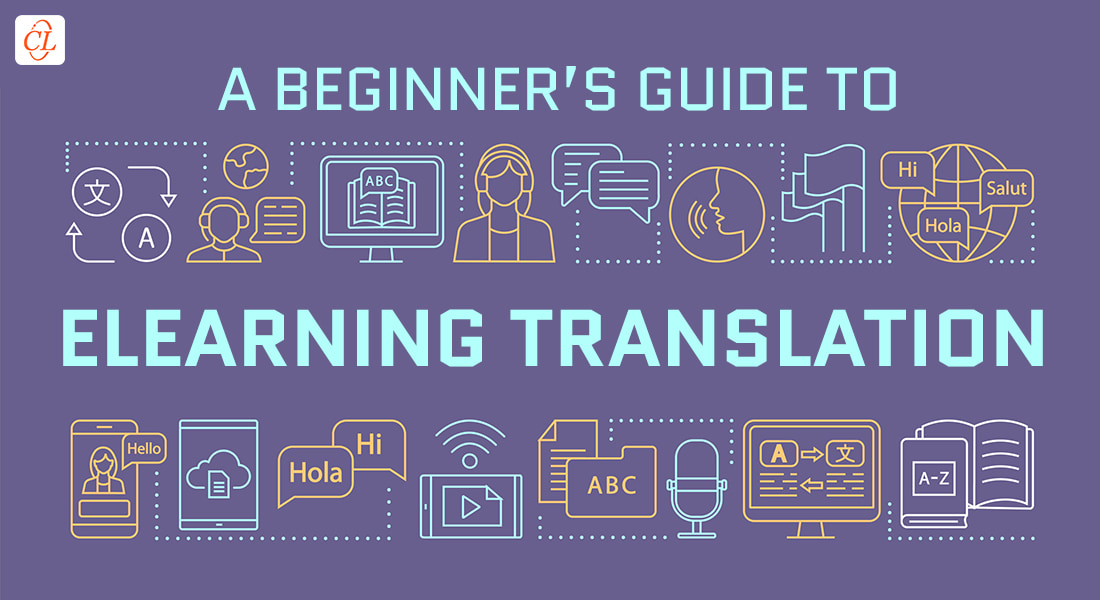A Brief Guide to eLearning Translation in Corporate training

You might ask yourself, should I bother to learn more about eLearning translation? If you have, then this post is for you!
The business world has become more connected than ever in the last two decades with the emergence of digital technologies and globalized corporate operations. The COVID-19 pandemic has further advanced these trends with the adoption of the remote work model. Today, thousands of companies have begun hiring employees from different parts of the world to expand their operations, reduce employee expenditure, outsource certain business functions, and gain access to a wider pool of talent.
However, this has put L&D teams in a bit of a predicament, as they have had to design corporate training programs for a multilingual workforce. The good news is the eLearning industry has also transformed in recent years with the emergence of authoring tools, training methods, and strategies. One of the most in-demand innovations of these has been eLearning translation.
Do You Want to Know More About eLearning Translation?
3 specific areas where eLearning translation can give you a tremendous boost
- Onboarding
- Sales training
- Compliance training
Scroll down to explore popular translation tools and a research-based process!
Organizations with globally dispersed employees are now leveraging eLearning translation to improve training outcomes and ROI. They’re translating their courses into their workers’ preferred languages.
If you’re intrigued by this prospect and looking to adopt this innovative solution, then keep on reading our beginner’s guide to eLearning translation.
What is eLearning Translation?
eLearning translation is converting digital training content, such as text, images, videos, and assessments from their original language to multiple, different languages. eLearning translation tools enable L&D teams to adapt their training courses according to their employees’ native languages. This helps improve engagement and participation and it expedites the learning curve.
Explore a success story of eLearning translation!
Most Common Use Cases of eLearning Translation
Many companies with international employees benefit from eLearning translation. Translated courses come in handy and are useful for many purposes, including:
1. Multilingual Employees’ Onboarding
The most important use of eLearning translation is to train new employees that speak diverse languages. When you translate your employee onboarding program into the workers’ native languages, you make a better first impression, as they then see your company as one that prioritizes building connections through shared knowledge.
From an L&D perspective, this speeds up the learning process and helps trainers cover their objectives faster.
2. Sales Training
If you sell your products and services internationally, then translated eLearning courses help your teams quickly learn about your business and its valuable offerings. With a multilingual sales training module, you train your workforce to explain the benefits and features of your products and services in your learners’ native languages.
3. Compliance Training
Multinational companies that operate in different regions and cultures need to adhere consistently to compliance standards that ensure their reputation and operational efficiency. When you translate your compliance training courses you make sure your multilingual team quickly gets up to speed with your organization’s culture, policies, SOPs, and ethics.
The Most Popular Authoring Tools for eLearning Translation
Today, there are a plethora of authoring tools in the market that you can use to create your own training program. However, no two authoring tools are equal and each one offers unique features. For instance, some are great for creating microlearning videos, while others provide multiple options to design assessments.
The following are a few tools we recommend for eLearning translation:
1. Lectora Inspire
Lectora Inspire is a powerful eLearning translation tool designed to create interactive and visually appealing courses with the option to publish in multiple global languages. When you use this tool, L&D teams can translate their content with a single click to extract the text that they need to translate into a rich text format (RTF) file and filter out any unwanted images or symbols.
2. Adobe Captivate
Adobe Captivate is one of the best rapid authoring tools in the market for creating responsive courses that enable mobile learning. It boasts a powerful geolocation feature that helps L&D teams create and adapt their training content to a specific location. This way, learners in the specified global locations can easily access the translated courses and assessments.
Should your employees be doubling up as translators?
3. Articulate Storyline 2 and 360
Articulate Storyline 2 is a relatively older authoring tool compared to Storyline 360. It’s used to create responsive eLearning courses for mobile devices. It offers export and import features than enable training teams to export text files that need translation and import the translated files. You can translate your courses into 28 different languages when you use this tool.
Storyline 360 offers the same number of languages as Articulate Storyline 2 but has recently added more regions and languages into its repertoire. A case in point, you can translate your course files to French dialects from Canada and France, English dialects from the US, UK, and Australia, Portuguese dialects from Brazil and Portugal, and Spanish dialects from Spain and Mexico. This powerful authoring tool also offers left-to-right alignment for Arabic, Hebrew, and other right-to-left scripts.
A Process to Ensure Accurate eLearning Translation
Now that you’re up to speed with the basics of eLearning translation, it’s time to dive into the business end of this article, that is, how to translate eLearning courses.
A translation project typically comprises five steps:
- Source content preparation (text, videos, images)
- Translation (audio narration, if required)
- Audio, video, and text integration
- Proofreading, QA, and delivery
This process sounds straightforward on paper, however, there’s a lot to consider when you want to achieve accurate eLearning translation. In this section, we outline each aspect of the process, so you have a better idea of what it entails:
1. Content Preparation
The first step to translate your training courses involves creating a global training strategy. This requires you take your target audience, that is your multilingual employees and the foreign market into consideration. You’ll be translating your course into complicated languages at this stage.
Keep the content simple and avoid idioms, analogies specific to a culture, complex vocabulary, and colloquialism to implement excellent eLearning translation.
2. Tool Procurement and Content Organization
Next, you need to leverage a powerful authoring tool, such as Storyline 360 or Lectora Inspire. Of course, you can always go for other tools available in the market. However, you should do your research so that you don’t waste time and money. You can choose to outsource the task to an eLearning vendor.
Make sure you gather all your training materials, such as text, videos, audio bytes, and images. At this stage, you might need to hire a linguist to help you with audio narration in case you don’t have an internal resource for this process.
3. Glossary and Content Style Development
At this stage, you need to develop a glossary encompassing the important terms you want to include in your translated courses so that you ensure consistency. The addition of a glossary will help the eLearning translation partner translate different terms that require clarification and are specific to your training. It will also help them filter out terms that don’t need to be translated.
4. Translation and Quality Control
Once you have your content all ready and translated, the eLearning translation vendor can use the authoring tool to publish translated courses into your desired language(s). Once the translation work is complete, they can also check its quality by reviewing the style and glossaries of the course and remove any errors or redundancies before deployment.
The Bottom Line
And there you have it. A simple guide to eLearning translation for corporate training managers. With this information, you have everything you need to develop a multilingual training program and upskill your employees in their preferred languages.
If you’re convinced that eLearning translation is for you, but you lack the tools or resources to incorporate this innovative solution into your training strategy, then you can outsource the task to experts or service providers specializing in eLearning translation and localization. And if you have more questions, get answers now before you proceed any further. Click on the link below.





